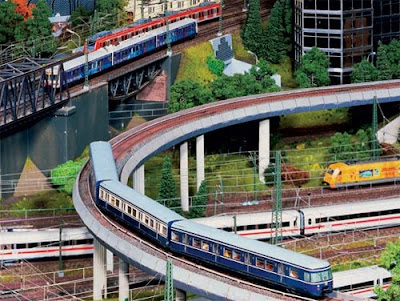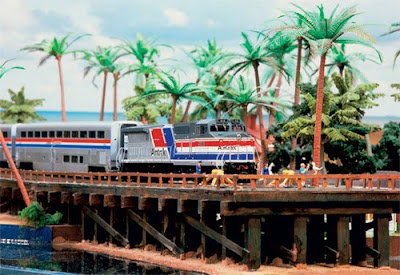Model Train Set Frederik Braun and his then-girlfriend and today’s wife were visiting the alpine city of Zurich in July 2000. Sauntering together through the alleys of Zurich’s center, they came across a railway model shop, which at once evoked childhood memories in Frederik.
During the following hours, the idea of realizing the long forgotten childhood dream became more and more mature. On the very same day he called his twin brother Gerrit and surprised him with the following words: „We are going to build the largest model railway in the world“.
Gerrit, who is more rational and sceptical by nature, doubted Frederik’s state of mind and didn’t take the idea too seriously. However, after having received about six more calls from Frederik enthusiastically presenting new ideas about this topic, Gerrit realized that his brother was very serious about it. So, he started thinking about the project from an economical and technical point of view.
The result was that the project is technically demanding, the economic aspect is very risky and from an entrepreneurial view it is crazy – but, still possible. Gerrit had been infected by this idea as well. The two brothers passed the coming days intensely planning their dream despite many doubts and misgivings from their environment.
Only a few days after Zurich’s enlightenment both of them were sure that they would engage in this adventure.
The world’s largest model railway and one of the most popular tourist attractions in Germany is located next to the Elbe in Hamburg’s Speicherstadt.
On more than 1,150 m² model area the Miniatur Wunderland ranges from Scandinavia to the USA, from the coast to the high mountains.
After final construction phase in 2015 model area will have more than 2.300 m² in 12 Construction Areas.
The Miniatur Wunderland has been constantly growing since the year 2001. Having started with two layout areas, Harz and Southern Germany, the Wunderland has openend the seventh area, Switzerland, in November 2007.
More layout areas have already been planned until the year 2014.
The Miniatur Wunderland have pursued the principle of open workshops since the beginning, which means that you can actually see his modellers and technicians working in the Wunderland and observe how landscapes emerge.

Up till now approx. 500,000 working hours and 8.7 Million Euros(11.7M $) they have put into the Miniatur Wunderland.

The Harz is one of the oldest landscapes in Miniatur Wunderland. It was built together with Austria and Knuffingen during the first construction phase (December 2000 – August 2001) and has become an important milestone in the renaissance of modelling.
The many stories and details which can be found in this section were groundbreaking for modelling, as well as the sea of lights at the carnival, and the action buttons.
You can see Wunderland’s people watching Romeo and Juliet dancing on the balcony at the open air theatre. Or have a look at Wunderland’s youths who copy Shakespeare’s love story in modern art in a field of sunflowers.
The Harz is also home to the ICE high speed route and more than 130 trains.
Knuffingen is, next to Austria and the Harz, the oldest layout part of the Miniatur Wunderland.
This city of 10,000 inhabitants, idyllically situated between the Harz and the Alps, is one of the largest cities in Miniatur Wunderland. Knuffingen is known for its innovations and has a worldwide reputation for its automobile industry.
The groundbreaking Carsystem of Miniatur Wunderland was initially installed in Knuffingen, and still is the largest in Wunderland with more than 90 cars.
The police in Knuffingen is also well equipped. A radar trap regularly catches truck drivers who are putting the pedal to the metal. The fire department Knuffingen is working at full capacity.
The central computer system is afflicted by the work of an arsonist who sets fires on different houses in the city. We haven’t been able to catch the arsonist yet, much to the annoyance of the fire department and the joy of our guests. So, the siren will be heard as a characteristic sound in Knuffingen for a long time to come.
Also worth mentioning is the cooperation of Hamburgs’ and Knuffingens’ THW, which work together in many respects. The city of Knuffingen has it’s own website on the Internet.
The Alps in Austria are by far not as high as the Alps in Switzerland, but considerably older. The Austrian section belongs to the primary layout of Miniatur Wunderland and was a big challenge for the team of the Wunderland in the year 2000.
The brothers Braun, both from the German lowlands, wanted Hamburg’s Alps to meet the satisfaction of Alpine dwellers. Moreover, every so-called “Fischkopp” (fish-head – a person from the coastal region of Germany), should be fascinated by the mountain layout in the Miniatur Wunderland as well.
The brothers Braun, both from the German lowlands, wanted Hamburg’s Alps to meet the satisfaction of Alpine dwellers. Moreover, every so-called “Fischkopp” (fish-head – a person from the coastal region of Germany), should be fascinated by the mountain layout in the Miniatur Wunderland as well.
Countless tons of plaster were added in numerous working hours, formed with a chisel, and later on painted. Wanting to illustrate authentic mountain life, typical attributes have been integrated. In the Wunderland Alps, all four seasons are mixed up. Besides skiers and figure skaters, there are also climbers and hikers exploring the fantastic green mountain pastures and rocky slopes.
Hamburg is the hometown of Miniatur Wunderland and the largest as well as the most densely populated city of the entire Wunderland (approx. 250 inhabitants per square meter live here).
Hamburg is the hometown of Miniatur Wunderland and the largest as well as the most densely populated city of the entire Wunderland (approx. 250 inhabitants per square meter live here).
About a quarter of the 50,000 inhabitants are gathering in the HSH Nordbank Arena in order to watch the local team of HSV beating the city rival St. Pauli by a pinch. But Hamburg offers many more attractions – for Wunderland’s people as well as for Wunderlands’ visitors.
The city of Hamburg has been created on 200 square meters, including all of the real cities’ most famous details. More than 1,500 trains, with Wunderland’s people from Scandinavia, Knuffingen or Switzerland arrive at Hamburg Mainstation daily.
From here, they leave for numerous attractions such as Hagenbecks Zoo, the Köhlbrandbrücke, St. Michael’s Church or the Wunderland within Wunderland. By the way, the smallest train of the exhibition at scale 1:900 circulates in Wunderlands’ Wunderland.
From here, they leave for numerous attractions such as Hagenbecks Zoo, the Köhlbrandbrücke, St. Michael’s Church or the Wunderland within Wunderland. By the way, the smallest train of the exhibition at scale 1:900 circulates in Wunderlands’ Wunderland.

The American section was opened in 2003, and strikingly, its surface is smaller than that of its neighbour Hamburg. However, it is’nt any less interesting.
The metropolis of Las Vegas, a paradise for gamblers in the desert, is the most luminous spot in Wunderland.
The metropolis of Las Vegas, a paradise for gamblers in the desert, is the most luminous spot in Wunderland.
More than 1/10 of all lights (over 300.000) installed throughout Wunderland – about 30,000, are located in this world-famous city.
But America has more breathtaking landscapes to offer. The Keys and Cape Canaveral directly pass into Las Vegas and the Grand Canyon is only separated by a highway from Mount Rushmore and Yosemite Park. The United States of Wunderland are, compared to other areas, not very big, however they are full of attractions.
The layout part of Scandinavia is the largest and technically most challenging part of Miniatur Wunderland.

In 2005 Scandinavia was opened by the consuls of the countries which have been reproduced in the Wunderland. The northern Baltic Sea is filled with 33,000 litres of running water and marks the centre of this layout part. There are many different ships crossing the ocean.
Currently, the fleet on the North Baltic Sea consists of 25 ships. We are developing an autopilot which enables 15-20 ships to navigate on the sea controlled by a computer. The ships are manually navigated presently. Scandinavia has many highlights to offer even without the revolutionary autopilot.
The interaction of water, snow, and light is unique in Wunderland. The simulation of high and low tide every 30 minutes is groundbreaking. However, there are a lot more attractions, such as an “adult” film set behind a dune, flying fairies, and a ghost ship on the Arctic Sea. The Scandinavian section is 300 m² large, and is one of the most popular layouts for visitors and employees.
The Swiss section spreads over two storeys on 250 square meters ( 2 691 sq ft ) and can already now be regarded as the highlight of the entire Wunderland! So far, 4 metric tons of plaster and 15 metric tons of steel have been used to build this section. A roughly 100 square meter ( 1 076 sq ft ) large hole in the ceiling enables the visitor to pass through a mine shaft in the 5,982 mm ( 19.6 feet ) high Matterhorn and view the miniature landscape from the summit.
Besides the Matterhorn, other highlights include the underground station Porta Alpina, the Glacier Express, the Open-Air festival, and as an extra teaser, the chocolate plant.
The Wunderland Mini-Switzerland represents 3 Swiss regions with their typical buildings and landscapes. The fourth floor, at an altitude of about 4.500 mm ( 14.7 feet ), Graubünden is shown with many regional landmarks and highlights like, for example, St.Max (aka St.Moritz).
The area around the foothills of the Matterhorn is built after the Wallis region. Most certainly one of the most striking Swiss regions.
And in the very far south of the Wunderland, “bella Italia” can be anticipated. The Ticino is packed with highlights. Apart from a huge Open-Air concert underneath a medievial fortress, medievial knight games, a failed bank robbery, and much, much more.
The Wunderland Mini-Switzerland represents 3 Swiss regions with their typical buildings and landscapes. The fourth floor, at an altitude of about 4.500 mm ( 14.7 feet ), Graubünden is shown with many regional landmarks and highlights like, for example, St.Max (aka St.Moritz).
The area around the foothills of the Matterhorn is built after the Wallis region. Most certainly one of the most striking Swiss regions.
And in the very far south of the Wunderland, “bella Italia” can be anticipated. The Ticino is packed with highlights. Apart from a huge Open-Air concert underneath a medievial fortress, medievial knight games, a failed bank robbery, and much, much more.

Within Wunderland’s Alps an airport of 150 square meters is under construction with every technical feature possible (Car System with supply vehicles, fire engines and the airplanes themselves).
The airport will for sure be the largest model airport in the world, where many different airplanes (from A 380 to Cessna) will operate.
The airport will for sure be the largest model airport in the world, where many different airplanes (from A 380 to Cessna) will operate.

















































































No comments:
Post a Comment